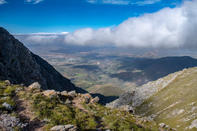A Useful Passage
The mountainous barrier between the Overberg and the Klein Karoo was first cracked at Cogmans Kloof, between present day Robertson and Montagu. But this useful passage was not discovered by intrepid explorers. It was revealed as a result of a native war party.

By the turn of the 18th century, a pass had already been established into the Roodezant, and the Land of Waveren, present-day Tulbagh, was being farmed with great success. Then, in 1701, a Khoikhoi tribe called the Koekemans spilled out of the Langeberg, through a gap in the rocks, and attacked this little farming community. The invaders were soon repulsed, but the pass had been revealed and the name stuck. Cogmans (Koekemans) Kloof quickly became a useful access route through the Langeberg.
In 1725, the first farms were granted in the Montagu Valley, on the far side of the Kloof, but access to the Cape remained difficult. Farmers who wanted to take their goods to market had to struggle through Cogmans Kloof, head up to Tulbagh and then scramble down the Roodezant Pass to the Cape.
A Muddy Track
This circuitous route was made even more daunting by the fact that Cogmans Kloof wasn’t much of a pass. It wasn’t even much of a road. Cogmans Kloof was actually just a muddy track that followed the banks of the Kingna River as it carved a narrow valley through the magnificent red rocks of the Cape Fold Mountains. Letting the river do all the work seemed like a good idea to the early transport riders, but the route had its drawbacks.
The Cogmans Kloof ‘road’ crossed the Kingna River eight or nine times during its passage through the kloof. When the water was high, the road was impassable. When the river was low, the drifts became muddy quagmires that trapped wagons like flies on sticky paper. To make matters worse, there was one thrusting piece of rock, called Kalkoenkrantz, which extended out into the river. At this point, the wagon drivers had no choice but to splash through the water until the obstacle had been cleared.
The farmers of the Montagu Valley kept asking the Cape government to improve the track, but help was not forthcoming. Occas
Difficult to Build

The problem was that there were just not enough convicts around. Convict labour was a mainstay of road construction in the Cape Colony, as free labourers, who, ironically, weren’t, tended to push the prices up. The bean-counters dragged their feet for a few more years, until it became clear that a proper road had to be built, with or without prisoners. The ever-present got the call in 1873, and he quickly staked out a safe course that ran above the river’s floodplain, avoiding the numerous crossings.
Although Cogmans Kloof is technically a poort, which follows a river through a mountain, rather than a pass, which climbs over a mountain, it was still difficult to build. Bain’s routing required a lot of cutting and blasting through the incredibly tough rocks. Nevertheless, he and his foreman persevered and by 1876, the road was nearly finished.
Only one little problem remained – Kalkoenkrantz. This narrow ridge of rock still forced wagons off the nice new road and into the river bed. The only solution was to build a tunnel through the bloody thing. Tunnel building was then a primitive art, but Bain was up for the challenge. However, his supplies of dynamite had run out, so Bain used unreliable gunpowder to blast away at the rock until, finally, he had blown a hole 16 m long and 5 m high through the Kalkoenkrantz. It is one of the earliest road tunnels in South Africa. The newly completed Cogmans Kloof road opened in 1877.
The Test of Time
Bain’s original road was improved in 1931 to cater for the increased traffic but, by 1952, it had again grown too small for the zooming motor cars. A new road was built and Bain’s tunnel was enlarged. Today, Bain’s original road can still be seen running on the opposite bank of the river, resolutely propped up by his characteristic dry-stone retaining walls. Bain’s old Hodges Bridge is also still standing, white and tidy, just next to the new Boy Retief Bridge, which carries the modern road.
The old road is closed to traffic nowadays, but it has stood the test of time. When he built it, Bain declared that it would survive any future flood that may come down the Kingna River. In 1981, on the same day that Laingsburg was devastated, Montagu also experienced its worst flood in living memory. The Montagu Springs complex was destroyed, and the new road was extensively damaged. Bain’s old road, however, was unharmed, and traffic was diverted onto the 100-year old roadway while the new road of 1952 was repaired.
Oh, and next time you drive through the Kalkoenkrantz Tunnel, look up and you will catch a glimpse of the British blockhouse built during the Anglo-Boer War to prevent the marauding Afrikaners from reaching Cape Town.